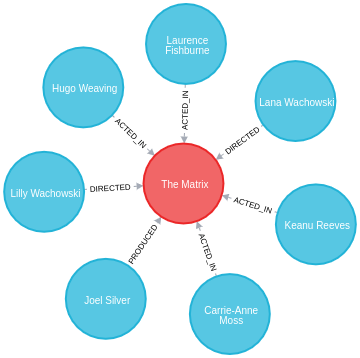apoc.export.csv.graph
Procedure APOC Core
apoc.export.csv.graph(graph,file,config) - exports given graph object as csv to the provided file
Signature
apoc.export.csv.graph(graph :: MAP?, file :: STRING?, config :: MAP?) :: (file :: STRING?, source :: STRING?, format :: STRING?, nodes :: INTEGER?, relationships :: INTEGER?, properties :: INTEGER?, time :: INTEGER?, rows :: INTEGER?, batchSize :: INTEGER?, batches :: INTEGER?, done :: BOOLEAN?, data :: STRING?)Output parameters
| Name | Type |
|---|---|
file |
STRING? |
source |
STRING? |
format |
STRING? |
nodes |
INTEGER? |
relationships |
INTEGER? |
properties |
INTEGER? |
time |
INTEGER? |
rows |
INTEGER? |
batchSize |
INTEGER? |
batches |
INTEGER? |
done |
BOOLEAN? |
data |
STRING? |
Usage Examples
The examples in this section are based on the following sample graph:
CREATE (TheMatrix:Movie {title:'The Matrix', released:1999, tagline:'Welcome to the Real World'})
CREATE (Keanu:Person {name:'Keanu Reeves', born:1964})
CREATE (Carrie:Person {name:'Carrie-Anne Moss', born:1967})
CREATE (Laurence:Person {name:'Laurence Fishburne', born:1961})
CREATE (Hugo:Person {name:'Hugo Weaving', born:1960})
CREATE (LillyW:Person {name:'Lilly Wachowski', born:1967})
CREATE (LanaW:Person {name:'Lana Wachowski', born:1965})
CREATE (JoelS:Person {name:'Joel Silver', born:1952})
CREATE
(Keanu)-[:ACTED_IN {roles:['Neo']}]->(TheMatrix),
(Carrie)-[:ACTED_IN {roles:['Trinity']}]->(TheMatrix),
(Laurence)-[:ACTED_IN {roles:['Morpheus']}]->(TheMatrix),
(Hugo)-[:ACTED_IN {roles:['Agent Smith']}]->(TheMatrix),
(LillyW)-[:DIRECTED]->(TheMatrix),
(LanaW)-[:DIRECTED]->(TheMatrix),
(JoelS)-[:PRODUCED]->(TheMatrix);The Neo4j Browser visualization below shows the imported graph:

The apoc.export.csv.graph procedure exports a virtual graph to a CSV file or as a stream.
The examples in this section are based on a virtual graph that contains all PRODUCED relationships and the nodes either side of that relationship.
The query below creates a virtual graph and stores it in memory with the name producers.cached using Static Value Storage.
MATCH path = (:Person)-[produced:PRODUCED]->(:Movie)
WITH collect(path) AS paths
CALL apoc.graph.fromPaths(paths, "producers", {})
YIELD graph AS g
CALL apoc.static.set("producers.cached", g)
YIELD value
RETURN value, gThe following query exports the virtual graph from static value storage to the file movies-producers.csv:
CALL apoc.export.csv.graph(apoc.static.get("producers.cached"), "movies-producers.csv", {})| file | source | format | nodes | relationships | properties | time | rows | batchSize | batches | done | data |
|---|---|---|---|---|---|---|---|---|---|---|---|
"movies-producers.csv" |
"graph: nodes(2), rels(1)" |
"csv" |
2 |
1 |
5 |
2 |
3 |
20000 |
1 |
TRUE |
NULL |
The contents of movies-producers.csv are shown below:
"_id","_labels","born","name","released","tagline","title","_start","_end","_type"
"195",":Person","1952","Joel Silver","","","",,,
"188",":Movie","","","1999","Welcome to the Real World","The Matrix",,,
,,,,,,,"195","188","PRODUCED"The following query returns a streams of the virtual graph from static value storage to the data column:
CALL apoc.export.csv.graph(apoc.static.get("producers.cached"), null, {stream: true})
YIELD file, nodes, relationships, properties, data
RETURN file, nodes, relationships, properties, data| file | nodes | relationships | properties | data |
|---|---|---|---|---|
NULL |
2 |
1 |
5 |
"\"_id\",\"_labels\",\"born\",\"name\",\"released\",\"tagline\",\"title\",\"_start\",\"_end\",\"_type\" \"195\",\":Person\",\"1952\",\"Joel Silver\",\"\",\"\",\"\",,, \"188\",\":Movie\",\"\",\"\",\"1999\",\"Welcome to the Real World\",\"The Matrix\",,, ,,,,,,,\"195\",\"188\",\"PRODUCED\" " |